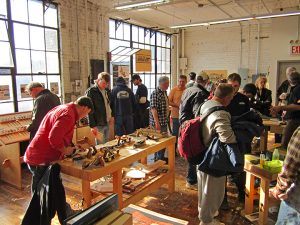We may receive a commission when you use our affiliate links. However, this does not impact our recommendations.
When you think about it, everything we do here at Popular Woodworking is about growth and development. We are in the business of helping to make people better woodworkers, plain and simple. I started thinking about how to break that down, and I came up with three methods that I believe every woodworker uses to grow and learn. I then bounced the idea off my colleague, Glen Huey, and also an external source – Robin Macgregor of Lie-Nielsen Toolworks. We all come from different backgrounds and experience levels, but we all agree that it comes down to some simple factors. See what you think!
Method #1. Try a different woodworking style. Build a few projects from a design lexicon that you have never used before. For many hobbyists, this means departing from Arts & Crafts or modernized Shaker into authentic period styles, or into contemporary modes. But it could just as easily be the opposite. I’m someone who didn’t know anything about Arts & Crafts a year ago, and still know very little, but have enjoyed growing as a woodworker by building a couple projects in this genre.
Method #2. Stick with a familiar style, but delve into more advanced forms or components. Glen says:
For the first year or so that I was building furniture – including the time I spent building pieces to get juried into shows – I was hesitant to make cabriole legs. Hesitant is probably not the right word; it was more like scared to death. I knew there would be no way I could produce four legs that looked the same, and I have yet to see a lowboy or highboy standing on a single cabriole leg. After some time, I felt it was important to slay that demon, so I milled my stock, sketched the pattern on the two adjacent faces and stepped up to my band saw. Cutting the shapes to the lines built my confidence, but I still needed to shape the legs – the hard work. One by one I completed the legs, comparing the second, third and fourth to the first. Set together there were differences, but spread apart as they would stand on the furniture, you couldn’t see any glaring variations. From that day forward, I have not purchased a single cabriole leg.
Method #3. Use either of the above methods, but don’t isolate yourself in your own shop – get out there and connect with other woodworkers! Robin says:
Early on in my growth as a woodworker, I learned a lot just by trial-and-error tinkering in my shop and referring to books or videos for advice. There’s no substitute for practice, practice, practice. But every so often, just when I thought I’d mastered a tool or technique (or dismissed it because I thought it was too complicated), someone would come along and reveal something I didn’t know – and didn’t know that I didn’t know. Suddenly a new world of possibilities would appear and I’d feel empowered to tackle more challenging projects. This is one of the main motivations behind the Hand Tool Event® program at Lie-Nielsen – gathering woodworkers of all skill levels in real shop environments to play with tools, learn new techniques, and help each other become better woodworkers!
Conclusion. You have to stretch your wings as a woodworker, or else you’re going to get bored with it. Whenever you find yourself saying, “I’ll do it this way because that’s the fastest or the best way to do it,” it means that you have developed a certain amount of experience (congratulations!) but also that you are in danger of getting a little stagnant. So go for some new territory!
In that same spirit, I encourage you to try our ebook subscription program. It’s such an easy way to get into every new style and technique you could ask for (methods #1 and #2 above). Give it a try! Then, as Robin pointed out, get out there and bounce the ideas off other woodworkers.
–Dan Farnbach
Here are some supplies and tools we find essential in our everyday work around the shop. We may receive a commission from sales referred by our links; however, we have carefully selected these products for their usefulness and quality.











I haven’t tried cabriole legs yet. Maybe I’ll go straight to the ball and claw.
Anyway, I’d buy doevetails if I could. I hate using router jigs because you waste a lot of time and scrap setting them up (well, I do, anyway). So, for now I’ll stick with the saw, or tennis racket, whatever it takes to get passable joints.